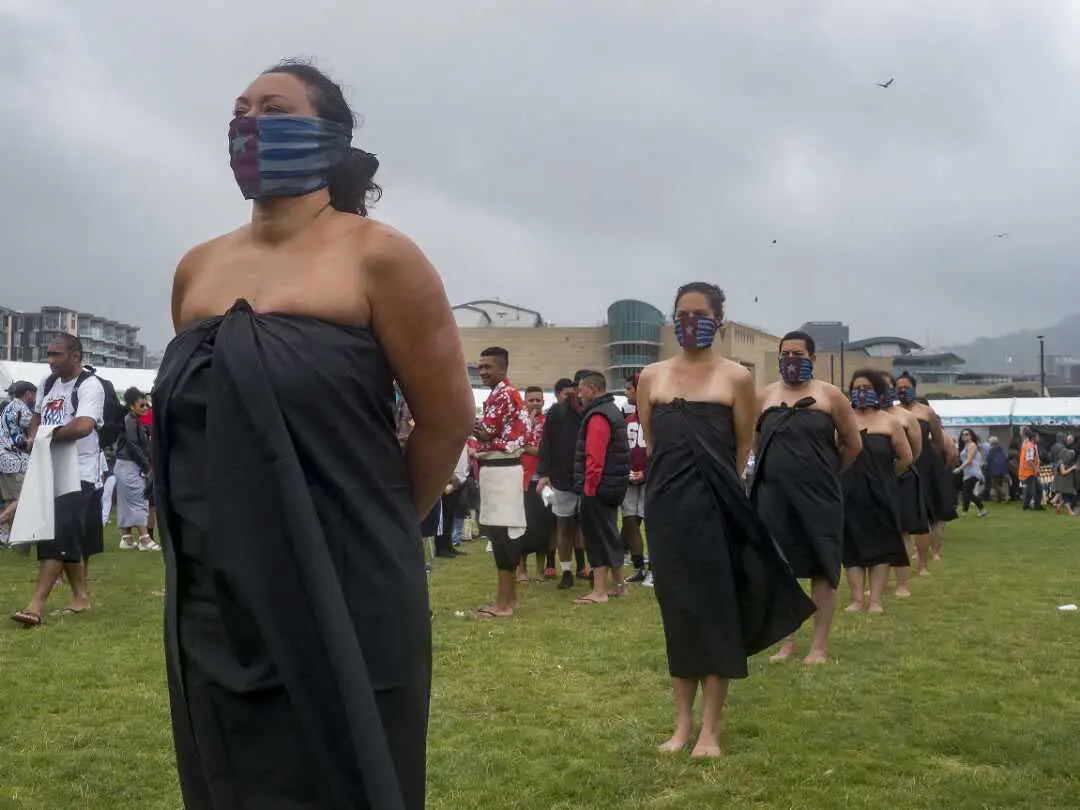
Māori and Pasifika
We come chanting, we come singing, we come proudly from Rangiātea, there our seed was sown We come, still voyaging by star canoes by aurora australis — Witi Ihimaera, ‘Oh Numi Tutelar’
Take an audio tour with Paul Diamond one of the curators of Pūkana. Paul shares stories and highlights from the exhibition.
Listen to Paul Diamond talk about ‘Māori and Pasifika’ in Pūkana
Transcript — Māori and Pasifika
And then the last part of the exhibition is a wee section looking at the connections between Māori and Pasifika. So early on in the research, I found an article by a man called Christopher Balme, who looked at the 1906 Christchurch exhibition. So this was a huge exhibition that a huge number of New Zealanders visited, and it was in Hagley Park in Christchurch.
And as part of that exhibition, there was a Māori village in Hagley Park. And the government also invited Pacific Islanders from the Cook Islands, from Rarotonga and Fiji. And there's a photo of Māori Fijians after a fire walking ceremony and Rarotongans meeting Pākehā. And they're all, sort of, in their traditional dress, including the Pākehā, who are in their silk top hats and formal dress.
And Christopher Balme in an article I found talked about how quoting from he said the juxtaposition of the Māori and Pacific Islanders in the same space was designed to demonstrate a double political and cultural strategy. He said more than 100 years later – or we've said, sorry – more than 100 years later politics and culture remain at the heart of pan Polynesian cultural identity but with different drivers.
Because Christopher Balme said you can trace a line from that exhibition in Christchurch and get to the Naked Samoans and to Bro'Town. And we suddenly realised there are all of these interconnections between Māori and Pacific peoples.
So beside that image of the rangatira from the Pacific and Pākehā, Ngati Pākehā greeting each other, we've got one of Dylan Owen’s images of women performing – sorry – protesting about West Papua. And that's outside Te Papa in 2015.
Really striking image of these women with the West Papuan flag used as a, sort of, a bandana around their faces. They're wearing – I think they're called parau, the garment – black garments. And actually you can't see from the image, but there are some images of Dylan's where you can see that actually from behind their hands are tied.
Then in a case below those images, there's the program for the first New Zealand Polynesian Festival, which became Matatini, the Māori Kapa Haka Performing Arts Festival. But what we didn't realise was that the first few festivals were actually all together they were Māori and Pasifika so and were for quite a few years. So that was interesting, and then we've got a image by Julia Brooke White who's donated photos from her collection to the Turnbull Library of Māori woman performing with palm trees in the background, because that's because they're at the 7th festival of Pacific arts.
So actually, although Polynesian Pacific island performance is no longer part of Matatini, there is still very close connections between Māori and Pasifika. And for example, the upcoming Festival of Pacific Arts, in fact, it's now common practice for each of those festivals, the winning team at Matatini goes to represent New Zealand.
Any errors with the transcript, let us know and we will fix them: [digital-services@dia.govt.nz](digital.services@dia.govt.nz?subject=Transcript update&body=Please add the link to the page you are emailing us about.)
Ngā Hononga ki Te Moana-nui-a-Kiwa
Ko tā Te Moana-nui-a-Kiwa he paihere i ōna iwi, e hē ana te whakaaro hei tauwehe te moana nui nei i a tātou i tēnei whaitua o te ao. I whakatere mai ngā tūpuna Māori mā Te Moana-nui-a-Kiwa kia tae mai ki Aotearoa, ā, koirā hoki te tipinga whakamutunga o ngā wairua Māori ki Hawaiki-nui, i muri i te reinga atu i Te Rerenga Wairua.
He mea tūhonohono ngā iwi Māori, ō te Moana-nui-a-Kiwa hoki mā roto i te whakapapa, i ngā tātai tuku iho, me te ao tōrangapū. He tini anō hoki ngā hononga mā roto i ngā mahi whakakite waiata, haka, e puta ana i ngā ahurei pēnei i te Festival of Pacific Arts and Culture me te Polynesian Festival, koia tērā te ingoa mō ngā ahurei i whānau ai a Te Matatini.
Kei ngā kohinga o te Whare Pukapuka o te Turnbull ētahi pānui whakaahua i whakakitea ai e ngā pēne Māori ā rātou waiata hei tautoko i ngā mahi kōkiri take i Te Moana-nui-a-Kiwa. E haere tonu ana ēnei mahi tū kotahi i ēnei rā, i te tūhonohonotanga o ngā iwi o ngā moutere me te iwi Māori kia tautoko tētahi i tētahi i tēnei ao.
Māori and Pasifika
Te Moana Nui a Kiwa, the Great Ocean of Kiwa, binds rather than separates us all in this region. It is across this Pacific Ocean that Māori ancestors sailed to reach Aotearoa, and over it that Māori spirits journey back to the ancient homeland of Hawaiki after leaping from Te Rerenga Wairua.
Māori and Pacific peoples are connected through whakapapa, history and politics. There are also many moments of connection through performance, which happen through events such as the Festival of Pacific Arts and Culture and the Polynesian Festival, a forerunner of Te Matatini.
The Turnbull Library collections include posters of events where Māori bands performed to support political activism in the Pacific. Such acts of solidarity still happen today, as Pacific and Māori people connect to support each other’s political struggles.
Oceania Interrupted protest for West Papua, 2015 by Dylan Owen, Dylan. Ref: PADL-001785. Alexander Turnbull Library.

Feature image at top of page: Postcards promoting Pūkana featuring Dame Kiri te Kanawa and Tina Cross. Photo by Mark Beatty.
